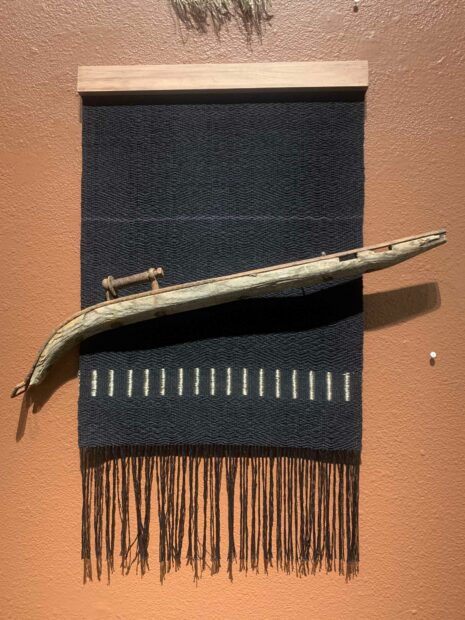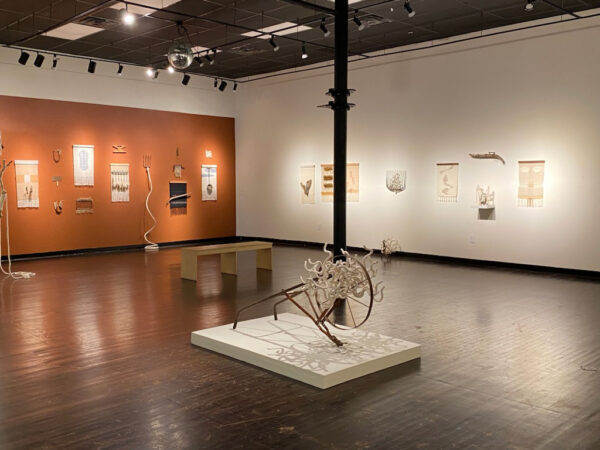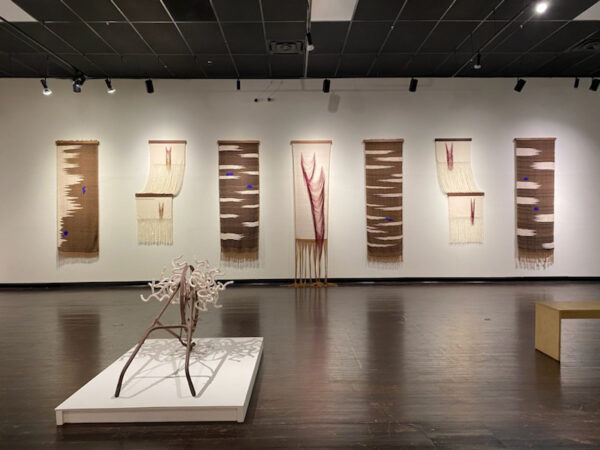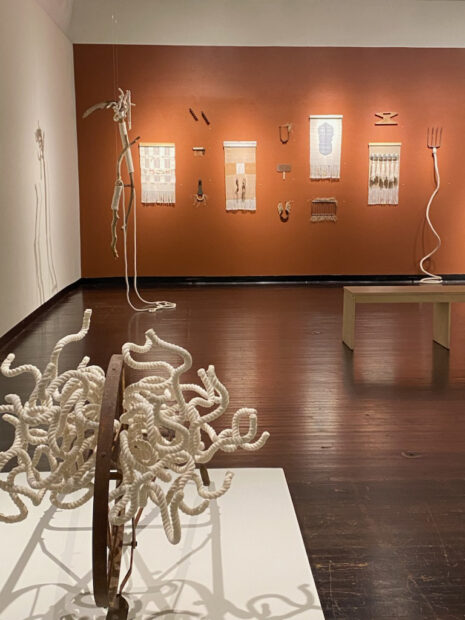Keeping fragile things, histories, and ideas hanging together — such is the essence of Jenelle Esparza’s art. Her new exhibit, Jenelle Esparza: A Selection of Stories Unearthed, delivers a comprehensive statement on the artist’s career to date, tracking her creative evolution between the years 2017 and 2023. Spread throughout the K Space Contemporary, a collection of weavings, charcoal drawings, and fiber-based assemblages offers an oblique glance at the histories of violence and the civil rights struggles that threaded through the rapidly expanding agriculture industry at the turn of the century.
The mixed-media piece Umbilical (2021) — one of the centerpieces in the show — is a bewildering sight to behold. A large scythe 65 inches long is suspended from the ceiling; coiled around its shaft is an undyed cotton rope, whose curls and sprigs bloom around the blade’s heel. At the bottom, the rope drops and loops along the floor before rising into the air again, where it is tied to a branch of a magnolia tree that hangs like a closed parenthesis.
The wraith-like construction of Umbilical offers a rich tangle of psychological and ecological resonances that is typical of Esparza’s conceptual use of material. Each object functions as a vector marking the interaction of different systems — the boom-and-bust cycles of farming, the migration and displacement of rural workers, the ecological dynamics braiding the web of life. By cleaving objects from their original use and reimagining them anew, Umbilical brings us closer to the ghostly traces of hard labor that are part of Esparza’s family experience.
Esparza’s formal training began in her undergraduate studies, where she specialized in photography. In 2017, she grew interested in textiles. During an Artpace residency in 2018, she initiated a project investigating what she calls “the physical, bodily experiences of labor.” In this pivotal period, she learned how to weave by enrolling in beginner-level classes. Her main piece of equipment (still used to this day) is the 36-inch Leclerc jack loom the art teacher sold her.
The conceptual direction of her work originated in research about her family lineage. Her late maternal grandmother, Idolina Quintanilla Olivarez, was the last in a generation of Mexican American cotton workers. According to Esparza, “Through my grandmother, I discovered my roots with the cotton plant, the state of Texas, the landscape…all the work I make now stems from that history and that lineage.”
As she began to delve deeper into records about her family and the cotton industry, her artwork became more idea-driven and materials-based. If she came across cotton growing on the side of the road, she would stop her car and pluck it from the ground, studying the plant’s aesthetic and physical qualities. This curiosity led her to photographing cotton fields in full bloom. Today, she fabricates textile-based artworks using naturally colored cotton that is Texas-grown, sourced from Stony Hill fiber arts, and sewn/spun in North Carolina and Georgia. As Esparza explains, “I like that this cotton has Texas roots.”
Decorated to resemble a history museum or flea market, the exhibition space is littered with discarded scythes, rakes, cultivators, hand-driven equipment, and horse-drawn plows that were commonplace in the early 20th century. These relics make startling cameos in weavings like Water Rising from Dirt (2023), where an iron ladle gently levitates above a textured surface of tan and blue colored yarn. Other wall hangings such as My Body Was Not My Own (2022) and What Could Never Leave Your Body (2022) exemplify Esparza’s concept of the “landscape tapestry.” In this practice, the artist gathers a collection of (dis)similar objects — family heirlooms, pieces of bark, obsolete tools — and recontextualizes them into new hybrid forms that evoke the contested geographies and temporalities of the Texas-Mexico border. Functioning as self-contained stories and time-capsules, these innovative works encourage a critical, searching, orientation toward the land.
For Esparza, the material presence of the body is just as important as memories of landscape. Bodies Swaying Above the Cotton Field Like Sheets on a Line (2022) is a haunting piece that abstractly relays images of racial violence. An antique coat hanger displays six tied-off pieces of yarn, using cotton to lament the lynching of ethnic Mexicans by Texas Rangers between 1915 and 1920. The Ranger (2022) replicates the toxic fantasies of militarization, policing, and American masculinity through the synecdoche of a broken firearm, which floats above and obscures the black-and-gold weaving behind it.
Esparza has stated, “I want my pieces to be complex, to be about healing and resilience. No open wounds on the wall.” A sequence of weavings titled Gathering Bones, located at the gallery entrance, illustrates this concern to avoid sensationalism or potentially triggering others when broaching difficult subjects of historical trauma. Seep (2018), with its frayed surface and gash of blood-like threads, presents a landscape torn apart by racial conflict. At the same time, the work is surrounded on both sides by complementary “healing” tapestries, Dancer in an Unconscious Rhythm I and II (2018). Inspired by blood platelets that appear blue under the microscope, the use of Japanese blue silk pulses across these pieces, implying reparative processes of healing scar-tissue while also pointing to the fact that Esparza is ultimately interested in working through pain and facing the past with open eyes.
Artistic research into the polysemic meanings of cotton is itself part of a rising trend. Interdisciplinary artists such as Kaneem Smith, Gina Gwen Palacios, and Margarita Cabrera have long mixed conceptualism and craft-based practices as a way to unravel the complexities of cotton within the cultural imagination of the Lone Star State. Esparza’s latest exhibit at K Space is indicative of how contemporary art variously positions cotton: as a creative material, a racialized agricultural commodity, and, finally, a witness for familial and ancestral heritage.
Above all, A Selection of Stories Unearthed solidifies Esparza’s growing reputation in the San Antonio art scene as a storyteller who blends conceptualism and craft practices like weaving, quilting, and embroidery as a way to uncover narratives of conflict associated with capitalist agriculture and the expansion of US empire.
Jenelle Esparza: A Selection of Stories Unearthed is on view at K Space Contemporary in Corpus Christi through February 22, 2024.






